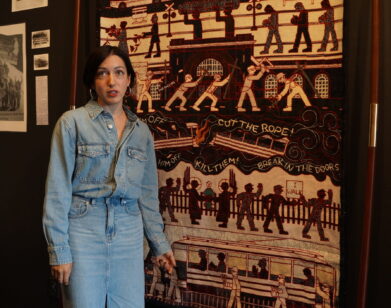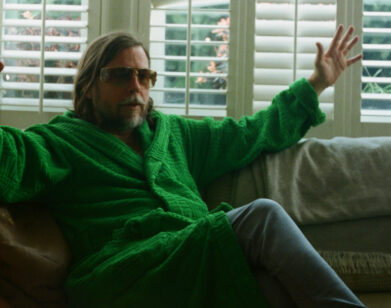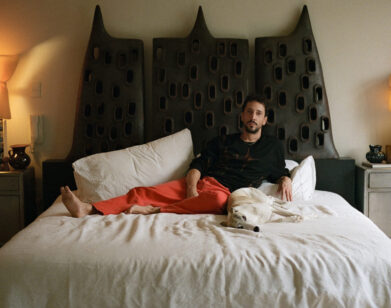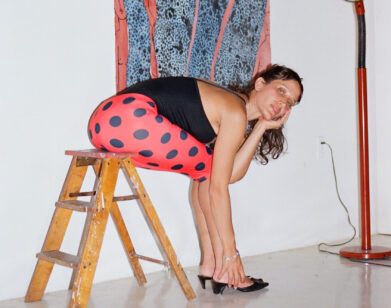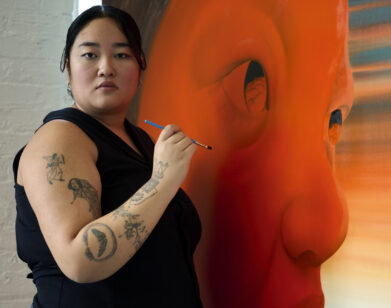Making Memories: Kerry Tribe at the Whitney Biennial
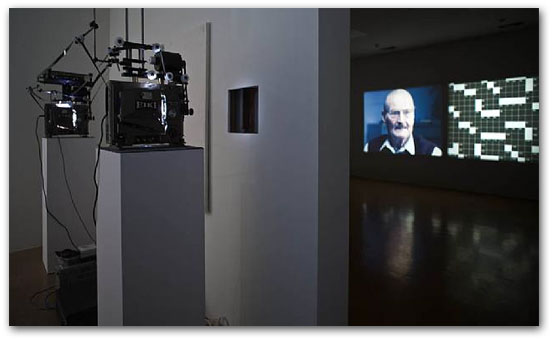
KERRY TRIBE, H.M. COURTESY THE ARTIST.
Kerry Tribe fits this year’s Whitney Biennial by its title alone, 2010. For over a decade her film and video works have dealt with the significance of time and how it is remembered: in other words, memory. Typically her projects match personal and cultural constructions of memory against ones rooted in fact and neurology, weaving a cinematic effect that forces viewers to simulate and analyze cognitive experiences at the same time.
Working between Los Angeles and Berlin, Tribe has staged a talk show in which she and old friends revisit intensely ambiguous event; recreated filmic depictions of a mid-blizzard car accident; and enlisted film theorist Peter Wollen to probe his then ten-year-old daughter Audrey on the metaphysical aspects of representation and identity. For the Biennial, Tribe presents H.M., a double projection of a single, 16mm film about “patient H.M.,” a man whose long-term memory was cut to a maximum of twenty seconds as the result of an experimental brain surgery in 1953. Exactly 20 seconds out of sync, the two side-by-side projections alternate between competing and dovetailing with each other as they recount the story of H.M.’s life.
KEVIN MCGARRY: More than once in your work people are asked whether they think of memories as things they go back in time to meet, or if they bring memories forward to meet them. Which do you think?
KERRY TRIBE: Memory does something funny to time, which we are accustomed to thinking of as linear and progressive. When we remember something, we bring it back to life. Neurologically, it’s as though the experience were happening to us in the present. And of course our memories are always subjective, selective and shifting-we remember what we need to, how we need to—the “Rashomon Effect.”
MCGARRY: Maybe you can call one up right now… how did you first learn of patient H.M. and his condition?
TRIBE: I first learned of patient H.M. years ago, from a guy who was working on one of my films. I found the story poignant and fascinating.
MCGARRY: And did the film come to you right away? The situation seems so tuned in to your interests.
TRIBE: It wasn’t until I started thinking about what might happen if you played one film through two consecutive projectors that his story came back to me as a possible subject. Once I learned that H.M. could only remember things for 20 seconds, the content and the form came together.
MCGARRY: And while unity of form and content is a key component to each of your films, cognitive unity is something they all strive to undermine…
TRIBE: Right. And it’s interesting, and sometimes really challenging, to make films that will be seen in a gallery, where the audience can come and go as they please. I mean, I try to keep them interesting enough that people will want to stay! But I’m working in a form that usually has narrative arcs—beginnings, middles and ends—in a context that doesn’t allow for that. So I try to think circularly, wherever someone enters, it works.
MCGARRY: Your own patterns tend to be a bit circular as well, in terms of where you and your family live and work throughout the year. What’s it like going back and forth between two cities as different as LA and Berlin?
TRIBE: Both are great cities to work in. And surprisingly, they’re not that different in many ways. Both are sprawling, have great art scenes, are relatively affordable. The movie industry of course has a pervasive effect on everything in LA, and that can be useful for my work. But in some ways I feel more at home in Berlin because of its progressive politics, culture, and navigability. But my German sucks, and ultimately I’m always a little relieved to come back.
THE WHITNEY BIENNIAL BEGINS ITS STRING OF OPENINGS TOMORROW. SEE ART IN AMERICA’S SPECIAL PROFILE, FIVE FROM THE WHITNEY BIENNIAL.

